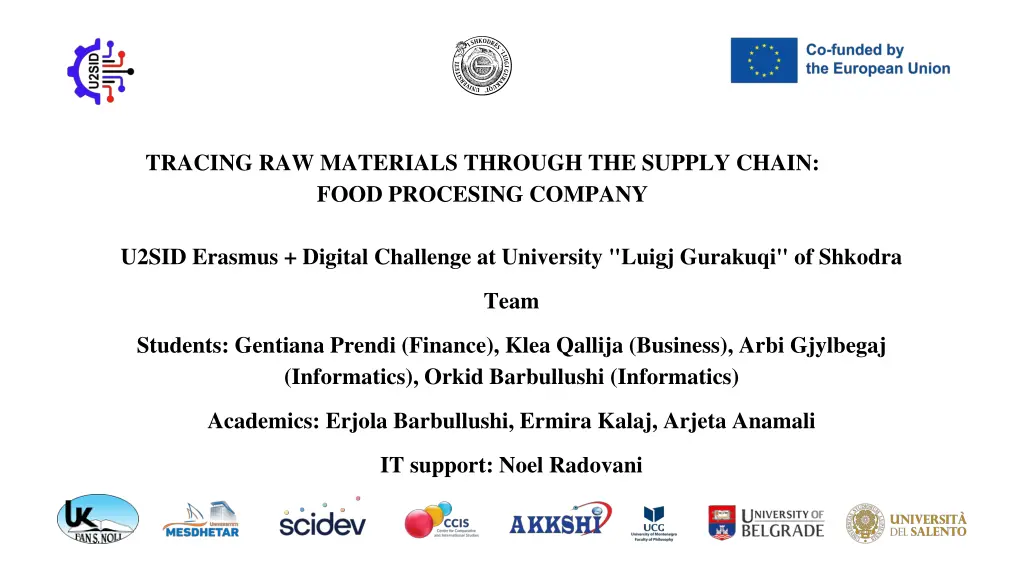
Enhancing Traceability in Food Processing Company Supply Chain
Discover how a team of students and academics from "Luigj Gurakuqi" University of Shkodra collaborated to design a traceability system for a local food processing company, aiming to meet food safety standards, enhance operational efficiency, and build customer trust.
Download Presentation

Please find below an Image/Link to download the presentation.
The content on the website is provided AS IS for your information and personal use only. It may not be sold, licensed, or shared on other websites without obtaining consent from the author. If you encounter any issues during the download, it is possible that the publisher has removed the file from their server.
You are allowed to download the files provided on this website for personal or commercial use, subject to the condition that they are used lawfully. All files are the property of their respective owners.
The content on the website is provided AS IS for your information and personal use only. It may not be sold, licensed, or shared on other websites without obtaining consent from the author.
E N D
Presentation Transcript
TRACING RAW MATERIALS THROUGH THE SUPPLY CHAIN: FOOD PROCESING COMPANY U2SID Erasmus + Digital Challenge at University "Luigj Gurakuqi" of Shkodra Team Students: Gentiana Prendi (Finance), Klea Qallija (Business), Arbi Gjylbegaj (Informatics), Orkid Barbullushi (Informatics) Academics: Erjola Barbullushi, Ermira Kalaj, Arjeta Anamali IT support: Noel Radovani
Outline : Executive summary of the project team Company's profile Objectives of the project team Methodology and data collection Solution proposal
Executive Summary This study focuses on enhancing the traceability of raw materials within a local food processing company. The goal was to design a traceability system that complies with national and EU food safety standards while improving operational efficiency and customer trust.
Company Profile The company was founded in 2002 in Shkoder; -6 mobile commercial units -2 shops, and two warehouses in Shkoder and Tirana -19 employees -30 products -Geographical distribution area reaches 17 cities
Objectives - Strengthen product recall management - Ensure compliance with food safety laws - Improve inventory management - Increase customer trust through transparency
Methodology Overview A mixed-methods approach was used, combining qualitative and quantitative data. - Structured interviews - Direct observations - Review of internal documents - System Development Life Cycle (SDLC) methodology
Data Collection Methods - Interviews with production, logistics, and IT staff - On-site observations of production processes - Analysis of technological cards and invoices - Review of Albanian and EU food safety regulations
System Development Life Cycle (SDLC) 1. Requirement Gathering 2. System Architecture Design 3. Database Structuring 4. Implementation 5. Testing and Validation
Key Findings - Lack of comprehensive traceability from production to sales - Potential compliance risks with food safety standards - Challenges in managing product recalls effectively - Significant investments in infrastructure (2018-2023) - Inefficiencies in product tracking and data integration - Reliance on manual data entry processes
Excel WorkBook Integration First solution - Implemented
Software development: Traceability System for Lot Numbers: From Production to Sales Figure 1. Link between PSN, NSLF, NIVF, NIPT a) Lot Number Generation Each product batch must be assigned a unique lot number at the time of production cited as Product Derial Number (PSN). Format Example: YYMMDD-PRODUCTCODE-SEQ (Example: 240204-MP-001 February 4, 2025, Meat Product Name, Batch 001) b) Data Captured Per Lot Raw material source (supplier, date of delivery) Production date & time Processing equipment used in case different equipments are used in processing different products Quality control results Storage & packaging c) Labeling & Scanning Each packaged product must have a barcode or QR code with the lot number.
Table 1- Technological Card- Beef Sausages INGREDIENTS 100 KG BATCH (LOT) SALT 1.8 28.08.2025 SPICE 1 0.3 16.05.2025 SPICE 2 0.25 L:0005674940002 SPICE F 0.73 L 01.04.2026 AROMA 1 0.06 L24DFBD 09/2026 COLOR 0.011 28.06.2027 LNP4D504 04/01/2027 STARCH 3 MEAT MINCE 50 L4268813491 WATER 15 - L789151504771366 00 BEEF MEAT 14
System Features Benefits of the System - Enhanced regulatory compliance - Improved operational efficiency - Increased customer trust and transparency - Streamlined product recall processes - Real-time tracking of product batches - Historical data storage and retrieval - User-friendly interface for staff
Regulatory Compliance Implementation Challenges - Albanian food safety laws - EU food safety regulations - Compliance with HACCP principles - Integration with tax authority systems for invoicing - Development time and resource allocation - Staff training and adaptation to new processes - Ensuring data security and integrity Project Timeline 1. Requirement Analysis Month 2-3 2. System Design Month 4-7 3. Development and Testing Month 8-14 4. Deployment and Training Month 15-17 5. Full Implementation Month 18-22
Expected Outcomes - Fully integrated traceability system - Improved food safety compliance - Streamlined operations and inventory management - Increased transparency and customer satisfaction
